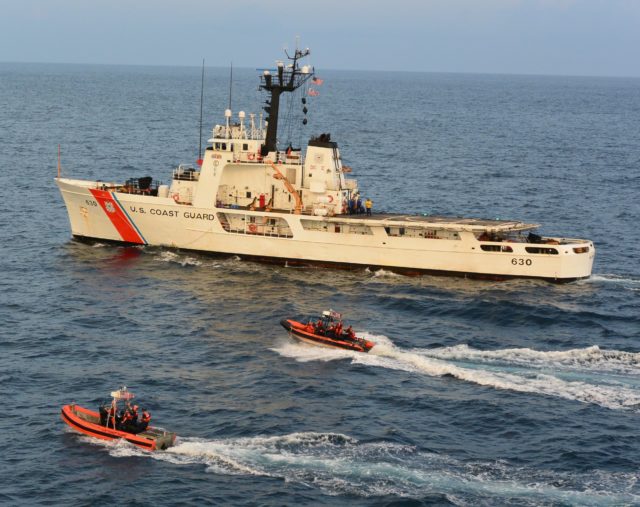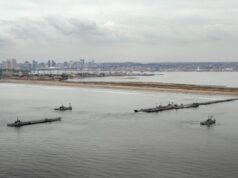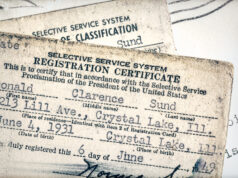
It is day 12 in the Eastern Pacific Ocean (EPAC) and the Astoria, Oregon-based Coast Guard Cutter ALERT has been away from homeport for 24 days already. This despite the ship being built 50 years ago with a maximum calculated endurance of 30 days. A target of interest (TOI) has been cued as the sun sets by 1800 (6:00 pm) at the lower latitudes and the sea goes from blue green to ink black.
The maritime patrol aircraft (MPA) was “bingo” fuel at 2000 and needed to return to base leaving ALERT alone in the vast EPAC with nothing but the ocean and the sky as companions for hundreds of miles around. The MPA provided the TOI’s last known position, course, and speed, and the watch team in the cutter’s Combat Information Center rapidly fixed its position 100 miles from the cutter. ALERT plotted an intercept course, but without the MPA, ALERT lost a critical component in detection capability in the cat-and-mouse game of hunter and hunted. Another aircraft would not be on scene for hours due to the distance offshore. ALERT would do its best with the limited capability organic to the cutter until a backup aircraft could arrive on scene.
The cutter Commanding Officer (CO) was left with a few options, but mostly educated guesswork based on time, speed, and distance equations at varying speeds and courses, so the position was a swag at best. The skipper looked around the combat information center and picked out the Operations Specialist First Class and said, “You pick the spot as it’s all a crap shoot.” The team discussed the pros and cons of the last known position and the likely course and came to all-stop in a position based on the in-depth experience of the cutter crew and sat in the darkness awaiting the arrival of the relief MPA, which was still two hours away.
The backup MPA checked in two hours later, at around 2200, and no sooner had the MPA radio operator exchanged pleasantries with the cutter, then the aircraft reported, “There’s a suspect go fast 10 nautical miles north of you, and he’s sitting dead in the water.” Unbelievable. The cutter ordered the go-fast bill be set, sending the entire 76-person crew into action. ALERT rapidly dispatched its cutter boat with a boarding team to intercept the target 10 miles away and well beyond visual and radar range of the cutter. As the cutter boat covertly inched its way north, the cutter took up a slow bell following in the wake, all in total darkness. The cutter, cutter boat, and MPA silently approached the target with all lights extinguished in an effort to prevent spooking the suspects into jettisoning evidence and fleeing.
The suspects aboard the TOI apparently counter-detected the cutter boat with its law enforcement team making its final approach. Now less than a mile separated the two small, darkened vessels approaching one another when the boarding officer reports, “They’re flashing a light at us!” “Well, flash back,” said the CO. And so it went, a flash was met by a flash right up until the small boat was alongside the TOI, a 35-foot, open construction panga-style vessel with a couple of outboard engines and several drums of fuel in front of the console. The look on the faces of the crew aboard the panga: priceless. A few muttered curses in Spanish followed as the boarding team assessed the situation and gained positive control of the suspect vessel and crew. What followed was the seizure of a ton of cocaine and apprehension of six suspects.
The Scope of the Problem
ALERT’s interdiction is not unique. The United States Coast Guard faces a nearly constant flow of drug-laden vessels. The Coast Guard stops a smuggling attempt every few days. On average, a single at-sea interdiction removes more than 2,000 pounds of deadly narcotics intended for high paying American consumers. Fiscal year 2018 saw a third straight year of the service removing more than 440,000 pounds of cocaine. In 2018, the Coast Guard removed 4.18 billion individual doses of cocaine (460,000 pounds) from American streets. That is the equivalent of a daily dose of cocaine for the entire U.S. population for 13 straight days.
Transnational criminal organizations use proceeds from illicit narcotics sales to fund an array of activities – very few of which do not result in regional destabilization. Violence caused by feuding cartels frequently encroaches on innocent civilians and legitimate business. Homicide rates attributed to cartel violence between the Jalisco, Sinaloa, and Juarez cartels in Mexico soared in recent decades. In 2018, TIME Magazine reported homicides eclipsed previous records, totaling nearly 35,000 in a single year. Descriptions of violent deaths, beheadings, mass graves, and daring prison escapes in Central America fill news feeds almost daily.
Neighboring countries in the Northern Triangle are equally influenced by cartels operating within their own borders. Tens of thousands of Salvadorians, Guatemalans, and Hondurans are forced from their homes due to drug-fueled violence, government corruption, and an inability of governments, police and militaries to provide necessary physical and financial security. Regional instability in the Northern Triangle has led to the displacement of more than 530,000 people according to the United Nations High Commission for Refugees (UNHCR). Many of these are children forced to abandon educations and embark upon a long journey fraught with danger of starvation, illness, violence, and more. These often desperate civilians become increasingly susceptible to becoming criminals themselves, or worse, human trafficking victims.
The Coast Guard leverages decades of illicit trafficking interdiction experience in its counter drug mission. However, America and other regional partners are currently combatting an unprecedented cocaine flow from South America. Over the past five years, the Coast Guard has tracked a steady increase in coca production in South America that correlates to increased interdictions. Smugglers exploit the vast canvas of water in the Western Hemisphere Transit Zone, which is comprised of primarily the EPAC waters off Central and South America and the Caribbean Sea. Drug smugglers operate all sorts of vessels to transport cocaine shipments from South America to intermediate destinations. They use fishing boats, sailing vessels, semi-submersibles, and the most common “go-fast” vessels: 30-to 40-foot open construction vessels capable of traveling in excess of 40 knots. The game is fast and ever-changing, creating a continued challenging environment for Coast Guard cutters and their crews of top-flight men and women.
The Role of the Coast Guard
Operating highly flexible enterprises capable of capitalizing on law enforcement weaknesses, competing demands and the limited resources of law enforcement, transnational criminal organizations hide among legitimate businesses. The Coast Guard is a key component in the United States Office of National Drug Control Policy’s National Drug Strategy. The goal is to prevent drug use, reduce illicit narcotics availability, and provide necessary treatment for those suffering from the disease of addiction. The Coast Guard maintains a layered security strategy to combat illicit trafficking networks by removing illicit narcotics supply and traffickers. Coast Guard removals provide law enforcement vital insight into criminal networks and their operations. This leads to future interdictions and prosecution cases against senior network leaders.
The Coast Guard leverages its unique authorities, competencies, capabilities, and partnerships to target drug cartels where they are most vulnerable. Operating hundreds of miles from any shore, the Coast Guard extends its border security function and removes bulk loads of contraband at sea before traffickers separate the bulk into smaller loads more easily concealed among legitimate traffic.
The Coast Guard targets shipments at a chokepoint in the supply chain where the product is consolidated in wholesale form. Upon arrival ashore in Central America, drug shipments are separated into hundreds of loads. Such dispersal requires law enforcement to target subdivisions of the same load, forcing impractical resource use. Furthermore, resellers in America add foreign substances to pure cocaine almost doubling the original product’s size.
Drug cartels have proven to be highly agile adversaries with a seemingly unlimited budget, and they are investing significant resources to build purposefully designed vessels capable of avoiding detection. These include low-profile go-fast vessels and semi-submersibles, which ride very low in the water with only inches of freeboard visible from the surface. These smuggling vessels are almost completely invisible to radar and can only be seen visually from directly above or within yards from the surface. Drug cartels design some of these drug smuggling vessels to carry loads in excess of 10,000 pounds of pure, uncut cocaine. The Coast Guard must continue to adapt and leverage technology and partner resources to continue to effectively dismantle illicit trafficking networks.
The Problems of Nature
From the rolling swells of the Eastern Pacific to the confused “washing machine” seas of the Caribbean, Coast Guard cutter crews come together at all times of the day and night to safely and effectively launch embarked boats and helicopters from rolling and pitching decks. Severe storms can come with little warning, turning the pursuit of a suspected drug smuggling vessel that spans hours into a battle with the elements.
Cutter boat coxswains deftly navigate through wind, waves, fog, sea spray and rain in darkness, rapidly adjusting the throttle as they crest each wave in pursuit of rapidly moving TOIs. Operating at speeds in excess of 30 knots, boat crews leave the safety and security of the parent cutter and depart over-the-horizon in search of a needle in a haystack that is adamant to remain undetected. Cutter boat crews outfitted with body armor, life jackets and weapons endure a white-knuckle ride aboard the 23-foot rigid hull inflatable boat with only a sliver of moonlight distinguishing the sea and the horizon ahead.
Additionally, particularly in the Caribbean, the threat of hurricanes from June through November is ever-present and a cutter may find itself conducting drug interdiction operations one day and humanitarian relief the next. Crews demonstrate expertise and flexibility in rapidly shifting gears across the service’s 11 statutory missions. The multifaceted threats of the maritime environment present no shortage of obstacles in pursuit of mission execution, and the adaptability of the Coast Guard breeds superior performance across all mission areas.
Key to the cutter ALERT’s story, and the continued success of Coast Guard cutters in the drug interdiction mission, is the MPA. Without MPA to pinpoint TOIs in the vast Western Hemisphere Transit Zone, an area described as larger than the continental United States, our cutters are swinging blind and only with a bit of luck and experience would they have made this seizure. Only a handful of Coast Guard cutters patrol the EPAC at any one time, akin to a handful of police cars patrolling the continental United States. Sticking with that analogy, intelligence targeting puts the cutter in the “same state or county” as a TOI, and the MPA enables the cutter to be “at the street address” and effect an interdiction.
The critical performance and participation of MPA is essential to success in the U.S. government’s continued efforts in maritime drug interdiction operations, a key arm in combatting transnational criminal organizations and reducing the availability of illicit drugs in the United States. The competing interests vying for flight hours is a challenge the Coast Guard contends with every year, if not every quarter, yet a surface asset hunting without MPA is almost like assigning someone to find a particular needle in a stack of needles, given the breadth of the ocean area smugglers use in the transit zone of the Western hemisphere.
CDR Patrick Culver is the Interdiction Division Chief (Drugs and Migrants). He, LT CDR Brian Chapman, LT CDR Paul Windt, and LT Sean Newmeyer are assigned to the Coast Guard’s Response Directorate in Washington.





